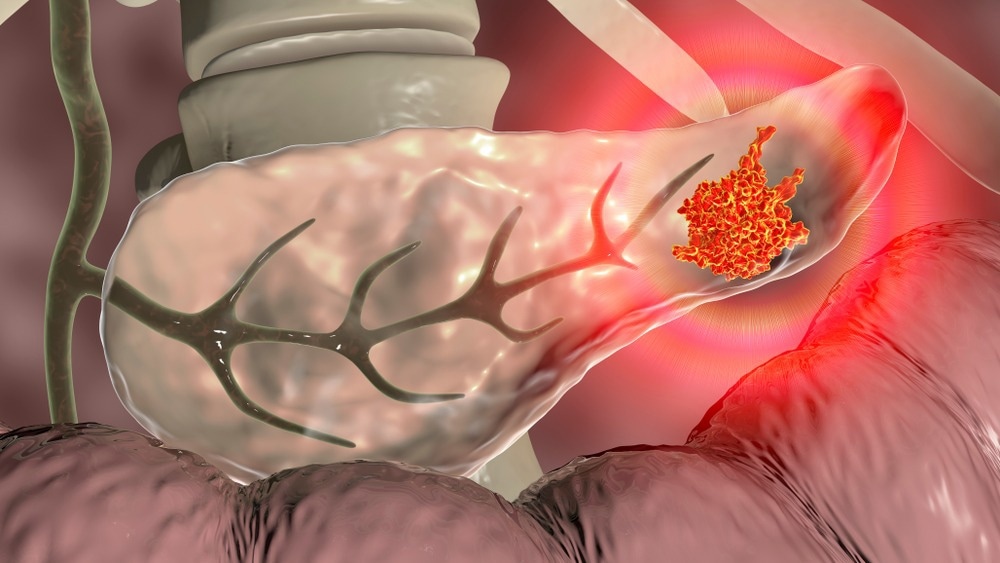I am Adrian Krainer, a Professor at Cold Spring Harbor Laboratory. My lab studies mRNA splicing mechanisms, its dysregulation in cancer and genetic diseases, and the development of RNA-targeted therapeutics.
Could you tell us about the pathology of pancreatic ductal adenocarcinoma (PDAC), as well as the currently available treatment options?
There are several subgroups of PDACs, with different combinations of genetic lesions and characteristics. Treatment options like surgery, radiotherapy, chemotherapy, or immunotherapy have limited effectiveness.

Image Credit: Kateryna Kon/Shutterstock.com
More than 90% of PDAC patients die within five years of diagnosis. Why is this the case, and what advancements are needed for this statistic to change?
The reason is that in most cases, by the time PDAC is diagnosed, it is already in the advanced stages, typically with metastatic spread. Early detection by means of predictive biomarkers, mechanistic insights, and new precision medicines could help improve the current statistics.
Your study aimed to explore the role of a genetic process called RNA splicing in pancreatic cancer. What is RNA splicing, and what is its significance to disease?
RNA splicing is an important step in gene expression that takes place in the nucleus of the cell and involves the cutting and joining of RNA segments. Most protein-coding genes comprise coding segments of DNA (exons), separated by non-coding segments (introns). When a gene is turned on, a precursor messenger RNA (pre-mRNA) is produced that also comprises the exons and introns. Then, the splicing machinery (spliceosome) locates the exon-intron boundaries, precisely removes the introns, and joins the appropriate exons, generating the spliced mRNA. Now the mRNA can be exported to the cell's cytoplasm, where it is translated by ribosomes to synthesize a protein.
Alternative splicing is when exons are joined in different combinations, such that one gene can give rise to two or more mRNAs and the corresponding proteins. Incorrect splicing can result in disease due to mutations in a gene that affect pre-mRNA features important for splicing, mutations in genes coding for components or regulators of the spliceosome, or an imbalance in the amounts of regulatory proteins.
How did you come upon splicing-regulator protein SRSF1 as your protein of interest for this study? What is the role of this protein within splicing?
We discovered this RNA-binding protein more than 30 years ago and have been studying its functions ever since. It belongs to a class of related proteins required for the assembly of the spliceosome and for splicing. The amounts of SRSF1 can fluctuate, and this affects the patterns of alternative splicing.

Image Credit: MattL_Images/Shutterstock.com
About 15 years ago, we reported that SRSF1 is present at abnormally high levels in various cancers, which can contribute to malignancy, such as breast cancer. In the present study, led by postdoctoral fellow Ledong Wan, we focused on PDAC after observing a correlation between elevated SRSF1 and decreased survival in PDAC patients.
Please could you tell us how you conducted your research and what your main findings were?
We used cells, organoids, and mouse models to investigate the effects of having too much or too little SRSF1 in ductal cells of the pancreas. We engineered mice that, when fed a small molecule in their diet, express double the normal amount of SRSF1 in the pancreas, which causes inflammation. If these animals also carry a mutant Kras oncogene—the most common driver of PDAC—increasing SRSF1 causes earlier and more severe malignancy.
Interestingly, in mice with mutant Kras, there is initially a decrease in SRSF1 levels as a way in which the cells attempt to resist the presence of mutant Kras. But eventually, SRSF1 escapes this control and becomes elevated (or we artificially increase its levels as mentioned above), and now it cooperates with mutant Kras to accelerate the formation and growth of tumors.
We identified changes in alternative splicing that occur under these conditions of elevated SRSF1, and as an example, we showed the importance of a spliced mRNA version coding for an interleukin receptor protein.
In your study, you utilized organoids—small versions of tumors. How can organoids influence pancreatic cancer research and therapeutics?
Organoids are 3D cultures of cells that retain important properties of the organs of origin better than cells grown in conventional 2D culture. We used both human and mouse organoids. They can be readily manipulated to introduce or remove genes, test candidate drugs, and measure these treatments' effects on various RNAs, proteins, etc. Thus, organoids can accelerate drug discovery because they can be manipulated faster and at a much larger scale than mice and yield more physiologically relevant results than cells grown in 2D.
How may your findings, in particular, the identification of SRSF1 as essential for PDAC growth, impact the area of treatment and therapeutics for PDAC?
The finding that SRSF1 promotes PDAC growth through changes in alternative splicing gives us a new way to understand this cancer. Further study may yield markers for early detection and targets for more effective therapeutic intervention. For example, if a key alternative splicing change is identified, it should be possible to reverse it using a type of precision drug called an antisense oligonucleotide (ASO).
How important is basic biological research for the improvement of human health?
I think it is essential. Even the most applied drug-development efforts depend on their success on earlier basic findings, and new basic findings are the key to innovation in drug discovery.
What is next for you and your research?
We have much more to do toward fully understanding the interplay between SRSF1 and mutant Kras in PDAC, defining key mediators of this interaction and pathological splicing changes, and developing therapeutic ASOs. More broadly, we will continue to study splicing mechanisms and splicing dysregulation in PDAC and other cancers and explore the full potential of ASOs.
Where can readers find more information?
About Adrian Krainer
Adrian Krainer is the St. Giles Professor at Cold Spring Harbor Laboratory and Deputy Director of Research at the CSHL NCI-designated Basic Cancer Center. He received a Ph.D. in Biochemistry at Harvard University. His research focuses on fundamental mechanisms of RNA splicing, the role of splicing dysregulation in genetic diseases and cancer, and the development of antisense therapeutics. He developed the ASO Spinraza, in collaboration with Ionis Pharmaceuticals and Biogen, as the first treatment for the neurodegenerative disease spinal muscular atrophy. He was elected to the National Academy of Sciences and the National Academy of Medicine, and is the recipient of the Life Sciences Breakthrough Prize, the Wolf Prize in Medicine, and the RNA Society's Lifetime Achievement Award.
His research focuses on fundamental mechanisms of RNA splicing, the role of splicing dysregulation in genetic diseases and cancer, and the development of antisense therapeutics. He developed the ASO Spinraza, in collaboration with Ionis Pharmaceuticals and Biogen, as the first treatment for the neurodegenerative disease spinal muscular atrophy. He was elected to the National Academy of Sciences and the National Academy of Medicine, and is the recipient of the Life Sciences Breakthrough Prize, the Wolf Prize in Medicine, and the RNA Society's Lifetime Achievement Award.